Sociology Report: Proxemics in Multicultural Australian Schools
VerifiedAdded on 2022/08/31

Proxemics in multiculturalism in Australian schools
Name of the student:
Name of the university:
Author note:
Paraphrase This Document

SOCIOLOGY
Abstract
The mode of this paper is that of explorative, which helps in excavating the aspect of
proxemics in multiculturalism in the Australian schools. An important them,, which the
researcher has inserted in the study is that of multiculturalism, which scans the
communication, which occurs between the persons from different cultures. An important
element in this communication is that of the space and territory. Allowance of others into the
space is exclusive decision of the persons in terms of their individuality. The method of
surveying 6 educators is apt in terms of gaining an insight into the approach toward planning
the implementation of the proxemic systems for maintaining equality in the schools premises.
This initiative reflects the transcendence from the personal to the social space for enhancing
the personality.

SOCIOLOGY
Table of contents
Introduction................................................................................................................................3
Design........................................................................................................................................3
Literature review........................................................................................................................3
Method.......................................................................................................................................8
Findings......................................................................................................................................8
Conclusion................................................................................................................................16
References................................................................................................................................17
⊘ This is a preview!⊘
Do you want full access?
Subscribe today to unlock all pages.

Trusted by 1+ million students worldwide
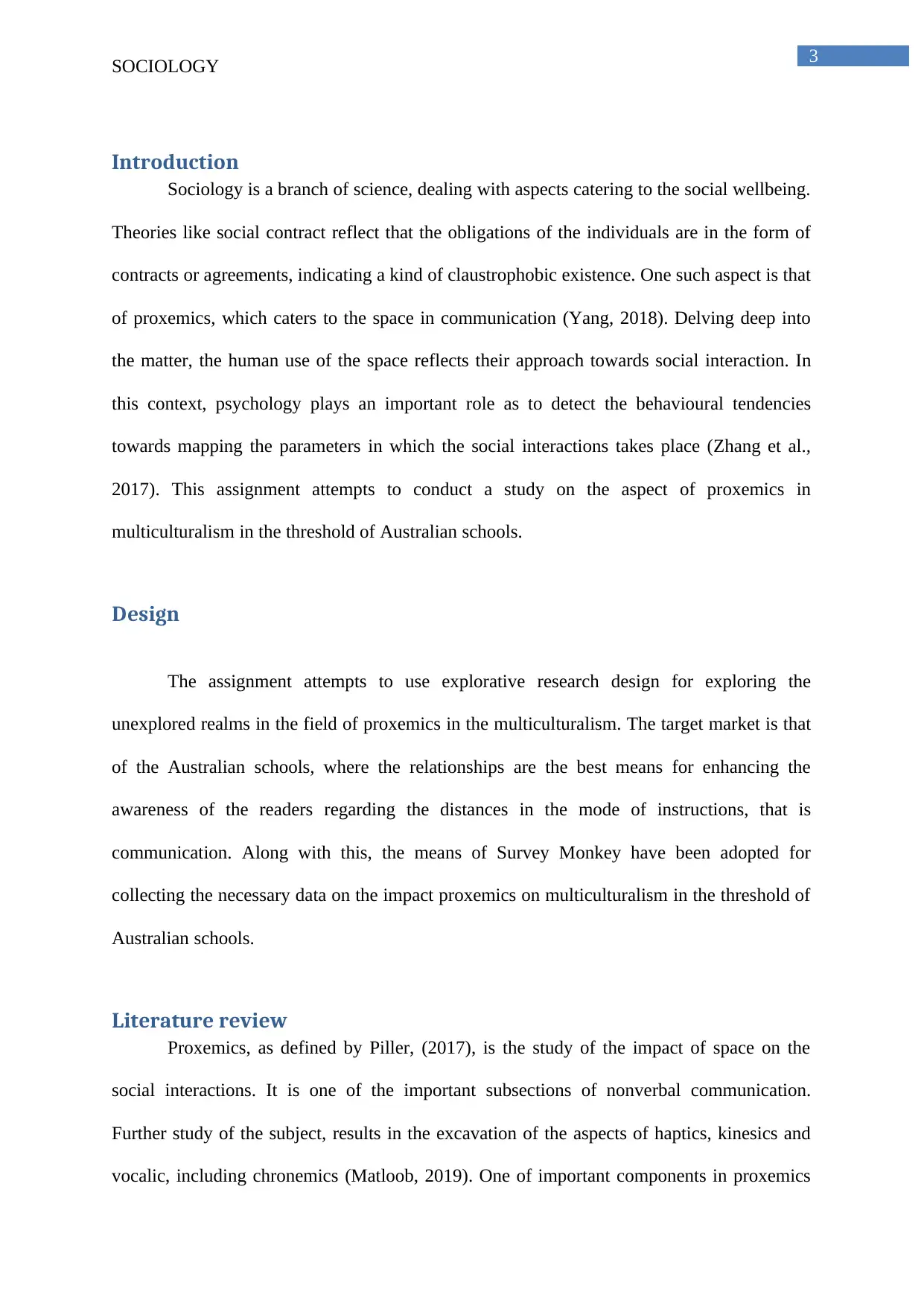
SOCIOLOGY
Introduction
Sociology is a branch of science, dealing with aspects catering to the social wellbeing.
Theories like social contract reflect that the obligations of the individuals are in the form of
contracts or agreements, indicating a kind of claustrophobic existence. One such aspect is that
of proxemics, which caters to the space in communication (Yang, 2018). Delving deep into
the matter, the human use of the space reflects their approach towards social interaction. In
this context, psychology plays an important role as to detect the behavioural tendencies
towards mapping the parameters in which the social interactions takes place (Zhang et al.,
2017). This assignment attempts to conduct a study on the aspect of proxemics in
multiculturalism in the threshold of Australian schools.
Design
The assignment attempts to use explorative research design for exploring the
unexplored realms in the field of proxemics in the multiculturalism. The target market is that
of the Australian schools, where the relationships are the best means for enhancing the
awareness of the readers regarding the distances in the mode of instructions, that is
communication. Along with this, the means of Survey Monkey have been adopted for
collecting the necessary data on the impact proxemics on multiculturalism in the threshold of
Australian schools.
Literature review
Proxemics, as defined by Piller, (2017), is the study of the impact of space on the
social interactions. It is one of the important subsections of nonverbal communication.
Further study of the subject, results in the excavation of the aspects of haptics, kinesics and
vocalic, including chronemics (Matloob, 2019). One of important components in proxemics
Paraphrase This Document

SOCIOLOGY
is the human distances, which is maintained in the process of communication. These
distances are referred as four different zones, which are intimate space, personal space, social
space and public space (Strzałka, 2019).
Fig: Human distance zones
(Source: Mahon, 2017)
According to the arguments of Britto, (2018), the distances, which surround the
person is the space. Personal space is the arena, where the persons experience comfort and
security by being amidst the near and dear ones. Intimacy is there at this stage with the
relatives, peers and friends. Social and public distances are maintained in the interactions
with others, with whom there are no familial relations. Depending on the relationship with the
people, the distances are horizontal and vertical. One of an important concept in this context
is biometrics, which Benjamin et al., (2019) considers being effective for exploring the
importance of space in communication, which is mostly nonverbal.
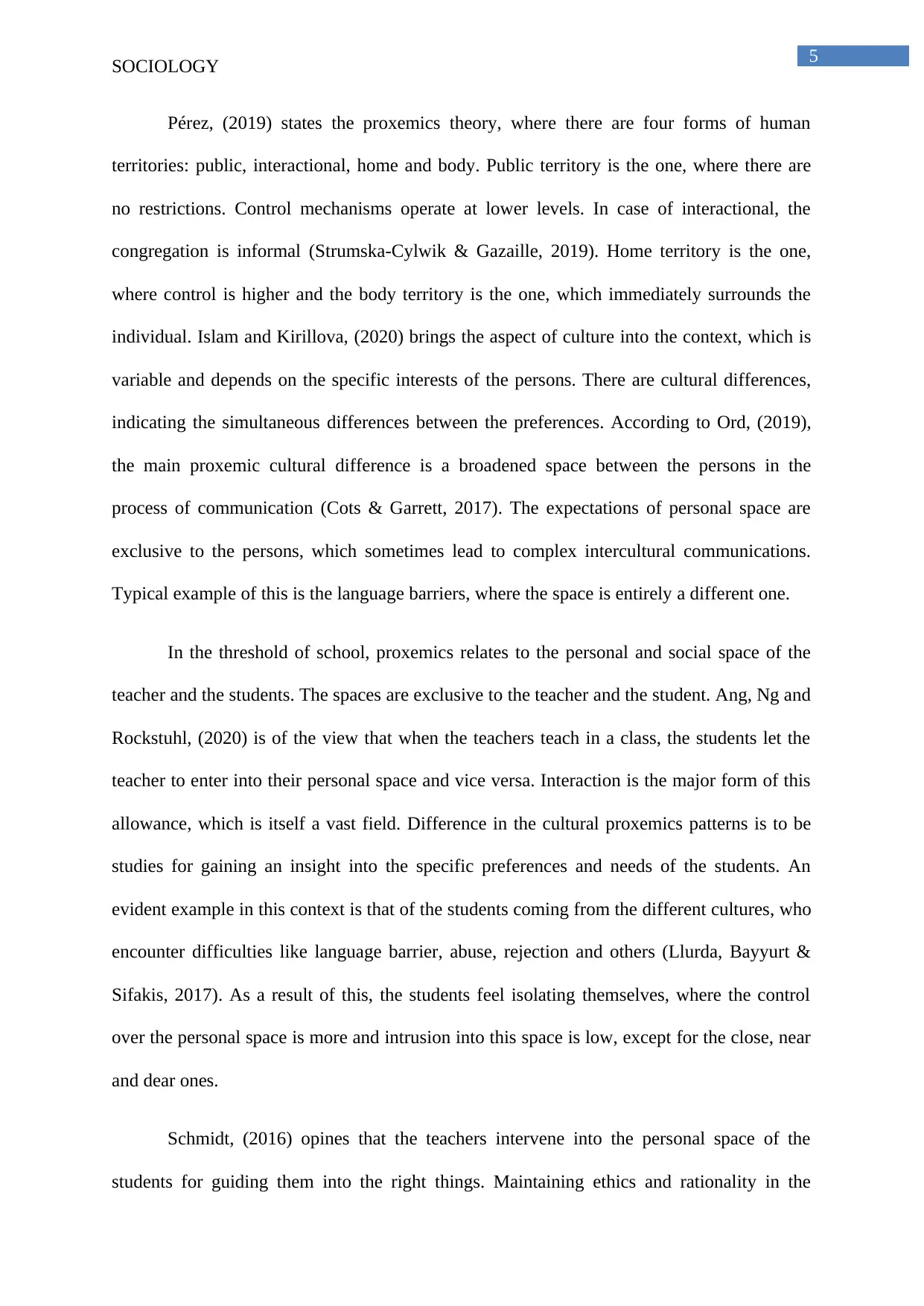
SOCIOLOGY
Pérez, (2019) states the proxemics theory, where there are four forms of human
territories: public, interactional, home and body. Public territory is the one, where there are
no restrictions. Control mechanisms operate at lower levels. In case of interactional, the
congregation is informal (Strumska-Cylwik & Gazaille, 2019). Home territory is the one,
where control is higher and the body territory is the one, which immediately surrounds the
individual. Islam and Kirillova, (2020) brings the aspect of culture into the context, which is
variable and depends on the specific interests of the persons. There are cultural differences,
indicating the simultaneous differences between the preferences. According to Ord, (2019),
the main proxemic cultural difference is a broadened space between the persons in the
process of communication (Cots & Garrett, 2017). The expectations of personal space are
exclusive to the persons, which sometimes lead to complex intercultural communications.
Typical example of this is the language barriers, where the space is entirely a different one.
In the threshold of school, proxemics relates to the personal and social space of the
teacher and the students. The spaces are exclusive to the teacher and the student. Ang, Ng and
Rockstuhl, (2020) is of the view that when the teachers teach in a class, the students let the
teacher to enter into their personal space and vice versa. Interaction is the major form of this
allowance, which is itself a vast field. Difference in the cultural proxemics patterns is to be
studies for gaining an insight into the specific preferences and needs of the students. An
evident example in this context is that of the students coming from the different cultures, who
encounter difficulties like language barrier, abuse, rejection and others (Llurda, Bayyurt &
Sifakis, 2017). As a result of this, the students feel isolating themselves, where the control
over the personal space is more and intrusion into this space is low, except for the close, near
and dear ones.
Schmidt, (2016) opines that the teachers intervene into the personal space of the
students for guiding them into the right things. Maintaining ethics and rationality in the
⊘ This is a preview!⊘
Do you want full access?
Subscribe today to unlock all pages.

Trusted by 1+ million students worldwide
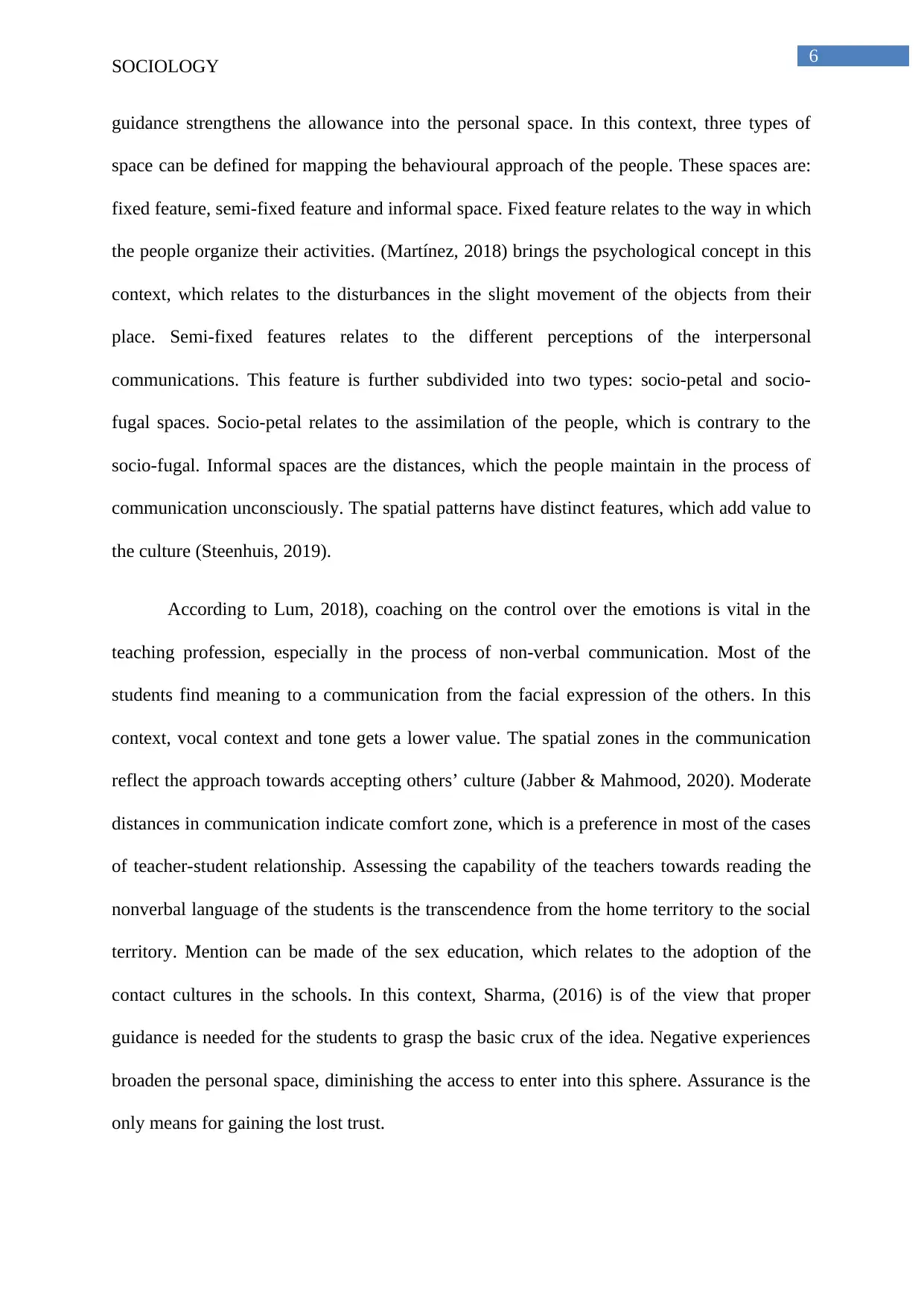
SOCIOLOGY
guidance strengthens the allowance into the personal space. In this context, three types of
space can be defined for mapping the behavioural approach of the people. These spaces are:
fixed feature, semi-fixed feature and informal space. Fixed feature relates to the way in which
the people organize their activities. (Martínez, 2018) brings the psychological concept in this
context, which relates to the disturbances in the slight movement of the objects from their
place. Semi-fixed features relates to the different perceptions of the interpersonal
communications. This feature is further subdivided into two types: socio-petal and socio-
fugal spaces. Socio-petal relates to the assimilation of the people, which is contrary to the
socio-fugal. Informal spaces are the distances, which the people maintain in the process of
communication unconsciously. The spatial patterns have distinct features, which add value to
the culture (Steenhuis, 2019).
According to Lum, 2018), coaching on the control over the emotions is vital in the
teaching profession, especially in the process of non-verbal communication. Most of the
students find meaning to a communication from the facial expression of the others. In this
context, vocal context and tone gets a lower value. The spatial zones in the communication
reflect the approach towards accepting others’ culture (Jabber & Mahmood, 2020). Moderate
distances in communication indicate comfort zone, which is a preference in most of the cases
of teacher-student relationship. Assessing the capability of the teachers towards reading the
nonverbal language of the students is the transcendence from the home territory to the social
territory. Mention can be made of the sex education, which relates to the adoption of the
contact cultures in the schools. In this context, Sharma, (2016) is of the view that proper
guidance is needed for the students to grasp the basic crux of the idea. Negative experiences
broaden the personal space, diminishing the access to enter into this sphere. Assurance is the
only means for gaining the lost trust.
Paraphrase This Document
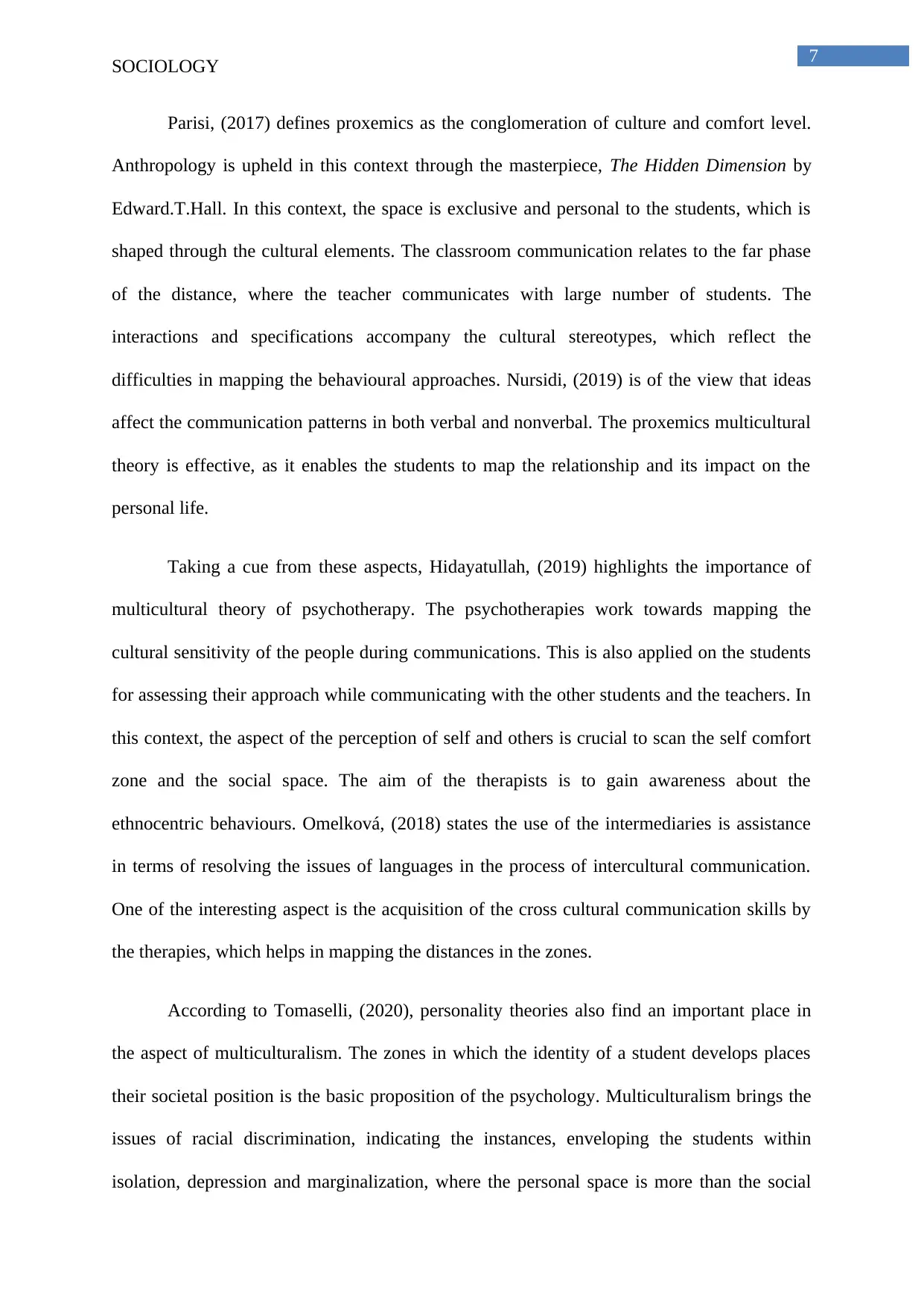
SOCIOLOGY
Parisi, (2017) defines proxemics as the conglomeration of culture and comfort level.
Anthropology is upheld in this context through the masterpiece, The Hidden Dimension by
Edward.T.Hall. In this context, the space is exclusive and personal to the students, which is
shaped through the cultural elements. The classroom communication relates to the far phase
of the distance, where the teacher communicates with large number of students. The
interactions and specifications accompany the cultural stereotypes, which reflect the
difficulties in mapping the behavioural approaches. Nursidi, (2019) is of the view that ideas
affect the communication patterns in both verbal and nonverbal. The proxemics multicultural
theory is effective, as it enables the students to map the relationship and its impact on the
personal life.
Taking a cue from these aspects, Hidayatullah, (2019) highlights the importance of
multicultural theory of psychotherapy. The psychotherapies work towards mapping the
cultural sensitivity of the people during communications. This is also applied on the students
for assessing their approach while communicating with the other students and the teachers. In
this context, the aspect of the perception of self and others is crucial to scan the self comfort
zone and the social space. The aim of the therapists is to gain awareness about the
ethnocentric behaviours. Omelková, (2018) states the use of the intermediaries is assistance
in terms of resolving the issues of languages in the process of intercultural communication.
One of the interesting aspect is the acquisition of the cross cultural communication skills by
the therapies, which helps in mapping the distances in the zones.
According to Tomaselli, (2020), personality theories also find an important place in
the aspect of multiculturalism. The zones in which the identity of a student develops places
their societal position is the basic proposition of the psychology. Multiculturalism brings the
issues of racial discrimination, indicating the instances, enveloping the students within
isolation, depression and marginalization, where the personal space is more than the social
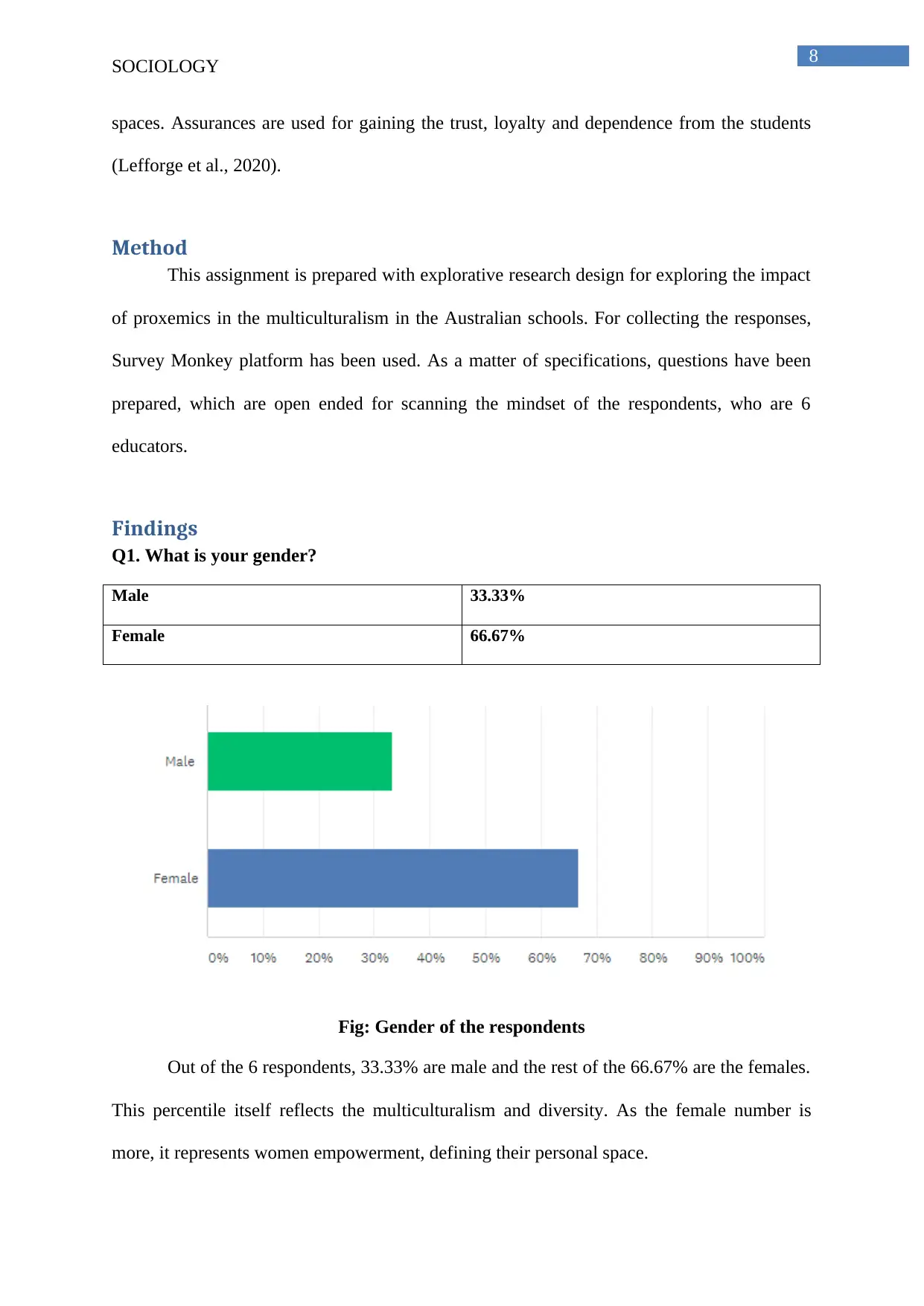
SOCIOLOGY
spaces. Assurances are used for gaining the trust, loyalty and dependence from the students
(Lefforge et al., 2020).
Method
This assignment is prepared with explorative research design for exploring the impact
of proxemics in the multiculturalism in the Australian schools. For collecting the responses,
Survey Monkey platform has been used. As a matter of specifications, questions have been
prepared, which are open ended for scanning the mindset of the respondents, who are 6
educators.
Findings
Q1. What is your gender?
Male 33.33%
Female 66.67%
Fig: Gender of the respondents
Out of the 6 respondents, 33.33% are male and the rest of the 66.67% are the females.
This percentile itself reflects the multiculturalism and diversity. As the female number is
more, it represents women empowerment, defining their personal space.
⊘ This is a preview!⊘
Do you want full access?
Subscribe today to unlock all pages.

Trusted by 1+ million students worldwide

SOCIOLOGY
Paraphrase This Document
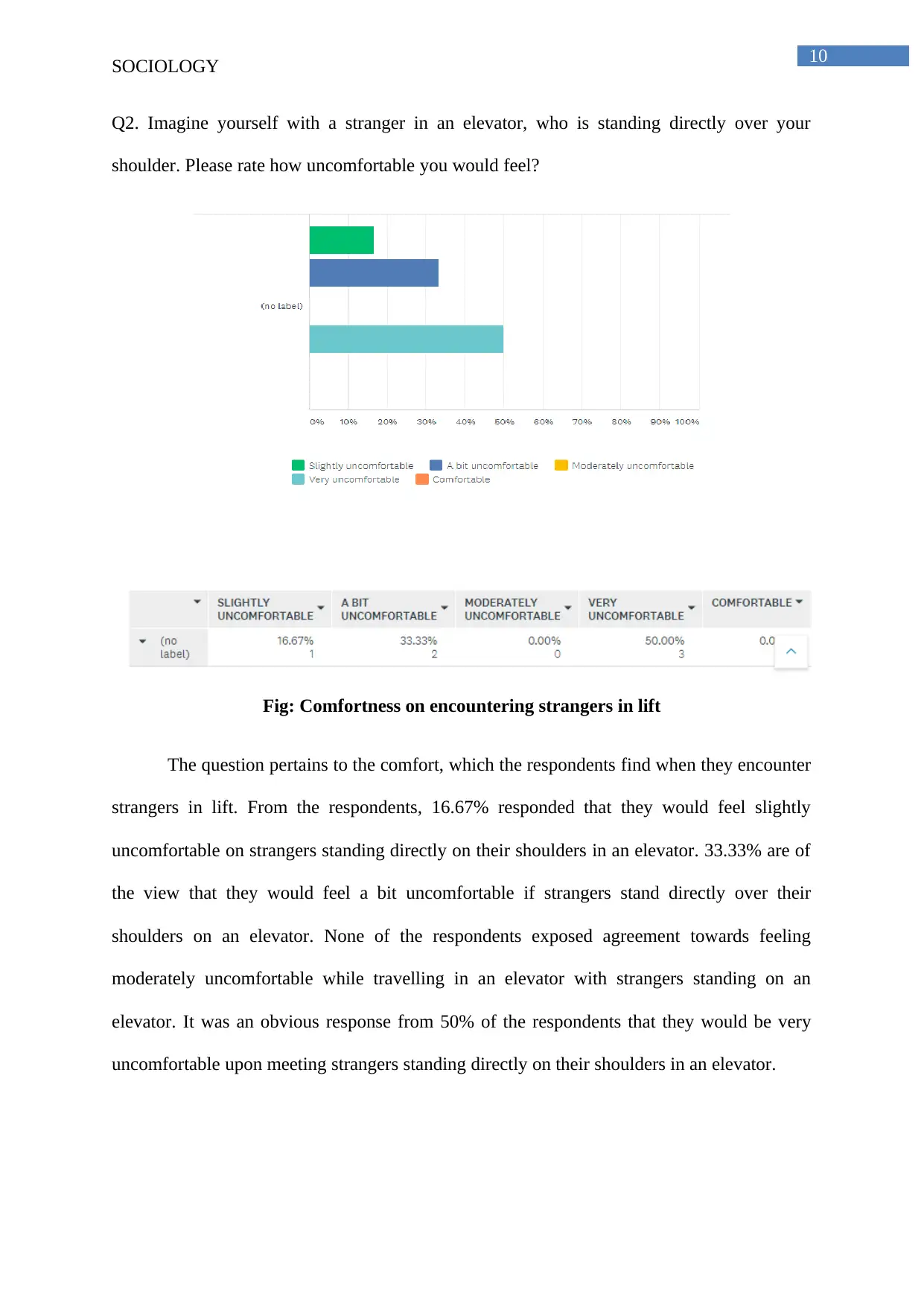
SOCIOLOGY
Q2. Imagine yourself with a stranger in an elevator, who is standing directly over your
shoulder. Please rate how uncomfortable you would feel?
Fig: Comfortness on encountering strangers in lift
The question pertains to the comfort, which the respondents find when they encounter
strangers in lift. From the respondents, 16.67% responded that they would feel slightly
uncomfortable on strangers standing directly on their shoulders in an elevator. 33.33% are of
the view that they would feel a bit uncomfortable if strangers stand directly over their
shoulders on an elevator. None of the respondents exposed agreement towards feeling
moderately uncomfortable while travelling in an elevator with strangers standing on an
elevator. It was an obvious response from 50% of the respondents that they would be very
uncomfortable upon meeting strangers standing directly on their shoulders in an elevator.

SOCIOLOGY
Q3. When you are having a conversation with a friend or family member, what kind of space
are you likely in?
Fig: Space in conversation
The question pertains to the space in conversation. 16.67% of the respondents
responded that while taking to family friends and friends, they are in the social space. The
same is applicable for the public space, which reflects the social interactions, which takes
place between the educators and the staffs, students and others. The story is same for the
conversations between the educators and their near and dear ones. Majority of the
⊘ This is a preview!⊘
Do you want full access?
Subscribe today to unlock all pages.

Trusted by 1+ million students worldwide

SOCIOLOGY
respondents, that is, 50% think that the conversations with the family members and friends
are the personal space, where intrusion of an outsider is the exclusive decision of the
individuals. This is the stage, where identity and expressions take shape from the social
interactions.
Q4. Which of the following describes the physical territory?
Fig: Physical territory
When asked about the physical territory, 2 out of the 6 respondents, that is, 33.33%,
cited the geographical space, where the communications occur. 3 out of the 6 respondents,
that is, 50% preferred the arrangement in space to be the physical territory. The rest of the
16.67% cited the closeness towards the romantic partner to be the physical territory. None of
Paraphrase This Document

SOCIOLOGY
the respondents opted for the familiarity in the space, which is not personal as that of the
home. This reflects that in most of the cases, the arrangements of the objects in the
surroundings affect the communications. Negative results enhance the personal space and the
home territory.
Q5. You are meeting friends at a restaurant you really like. You feel comfortable here,
but it’s not quite as personal your home. What kind of space is this restaurant,
according to proxemics?
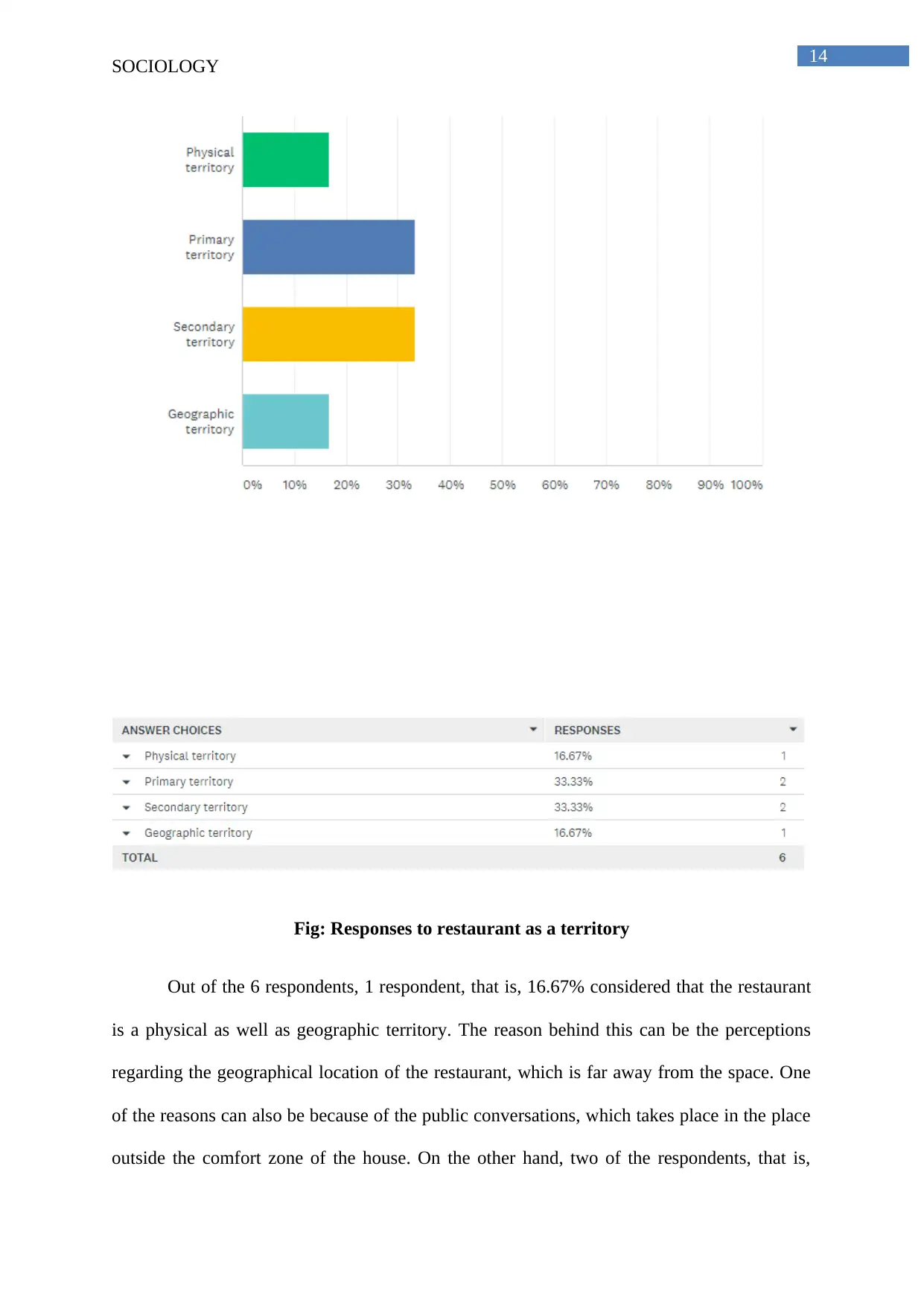
SOCIOLOGY
Fig: Responses to restaurant as a territory
Out of the 6 respondents, 1 respondent, that is, 16.67% considered that the restaurant
is a physical as well as geographic territory. The reason behind this can be the perceptions
regarding the geographical location of the restaurant, which is far away from the space. One
of the reasons can also be because of the public conversations, which takes place in the place
outside the comfort zone of the house. On the other hand, two of the respondents, that is,
⊘ This is a preview!⊘
Do you want full access?
Subscribe today to unlock all pages.

Trusted by 1+ million students worldwide
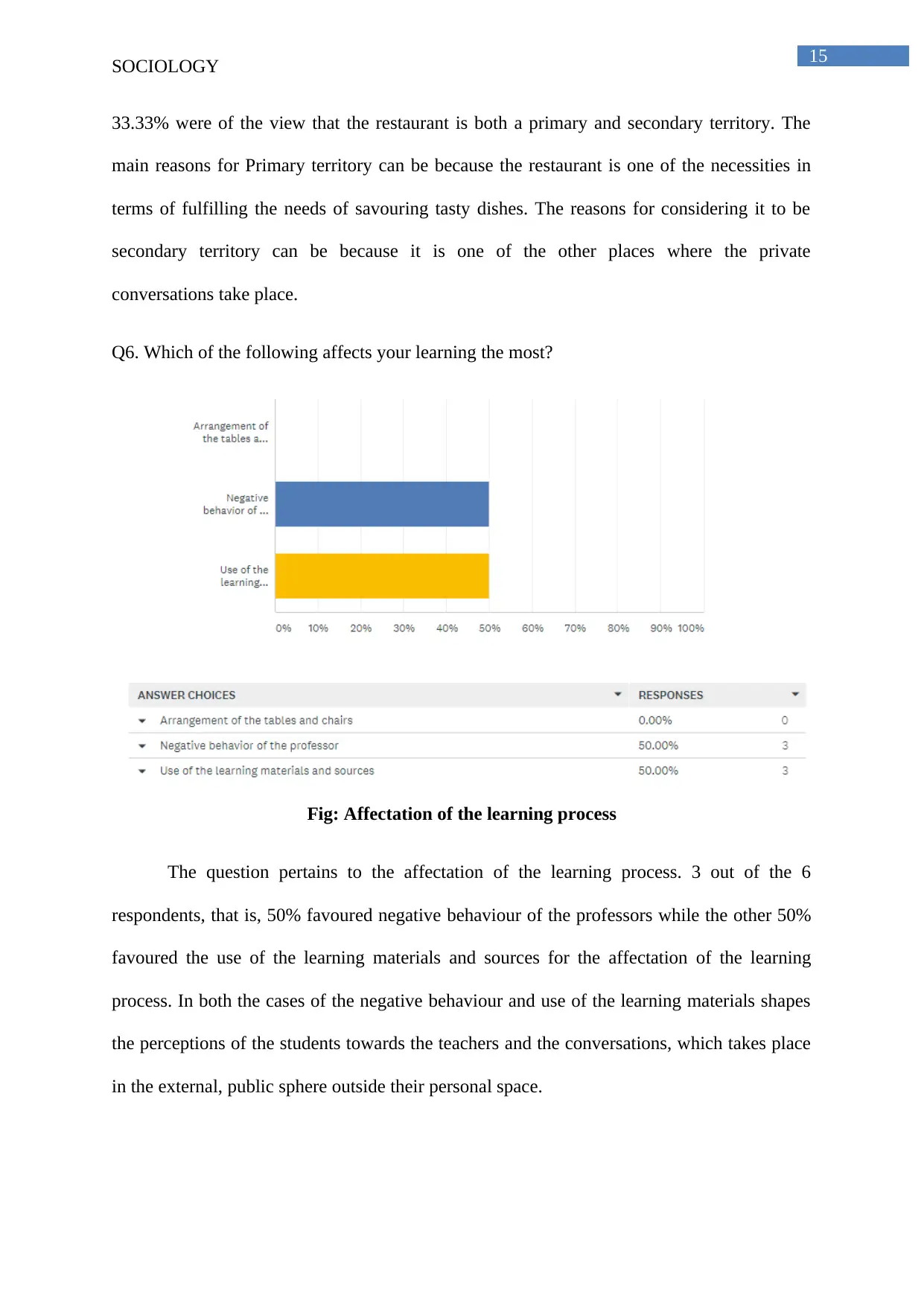
SOCIOLOGY
33.33% were of the view that the restaurant is both a primary and secondary territory. The
main reasons for Primary territory can be because the restaurant is one of the necessities in
terms of fulfilling the needs of savouring tasty dishes. The reasons for considering it to be
secondary territory can be because it is one of the other places where the private
conversations take place.
Q6. Which of the following affects your learning the most?
Fig: Affectation of the learning process
The question pertains to the affectation of the learning process. 3 out of the 6
respondents, that is, 50% favoured negative behaviour of the professors while the other 50%
favoured the use of the learning materials and sources for the affectation of the learning
process. In both the cases of the negative behaviour and use of the learning materials shapes
the perceptions of the students towards the teachers and the conversations, which takes place
in the external, public sphere outside their personal space.
Paraphrase This Document
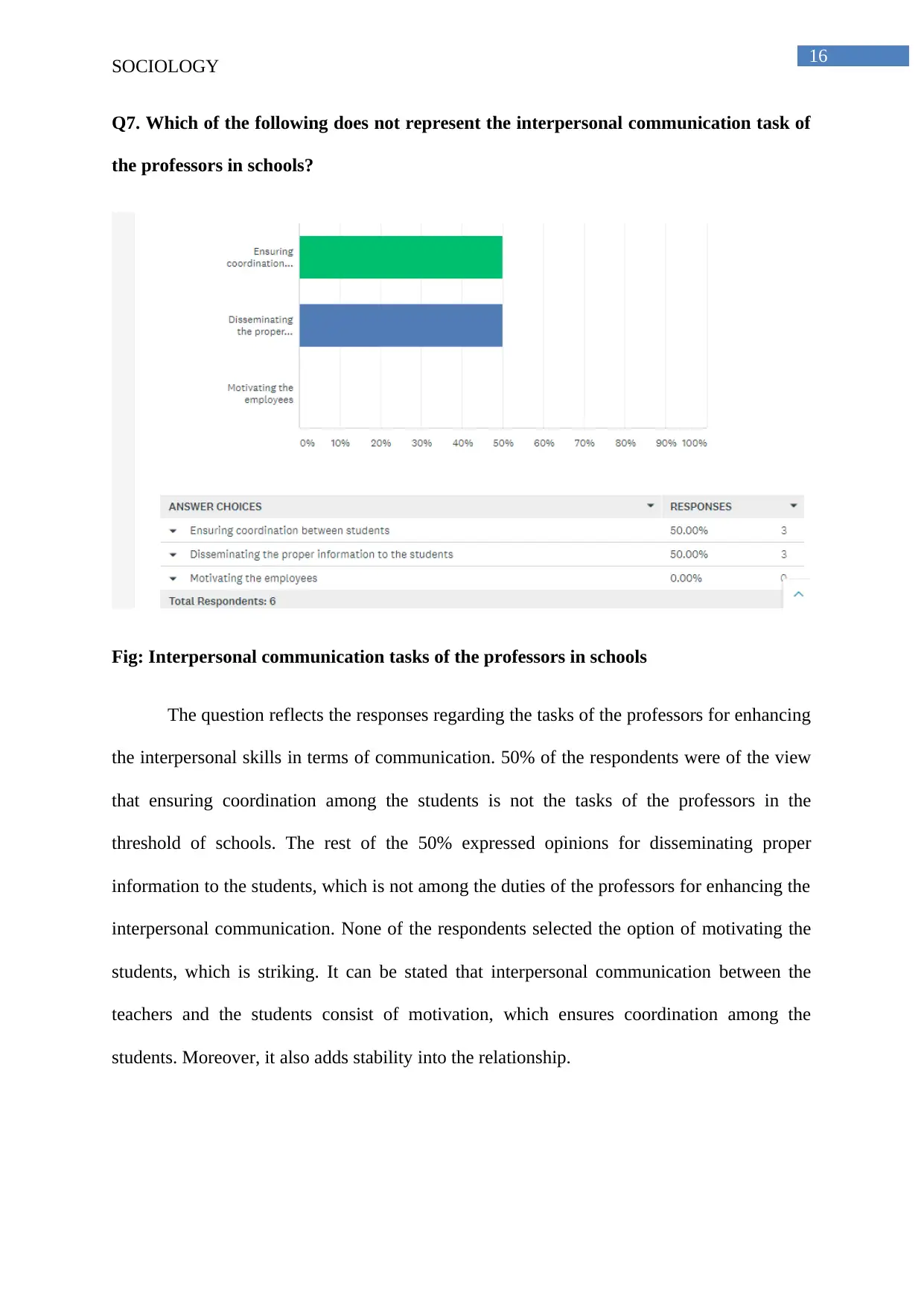
SOCIOLOGY
Q7. Which of the following does not represent the interpersonal communication task of
the professors in schools?
Fig: Interpersonal communication tasks of the professors in schools
The question reflects the responses regarding the tasks of the professors for enhancing
the interpersonal skills in terms of communication. 50% of the respondents were of the view
that ensuring coordination among the students is not the tasks of the professors in the
threshold of schools. The rest of the 50% expressed opinions for disseminating proper
information to the students, which is not among the duties of the professors for enhancing the
interpersonal communication. None of the respondents selected the option of motivating the
students, which is striking. It can be stated that interpersonal communication between the
teachers and the students consist of motivation, which ensures coordination among the
students. Moreover, it also adds stability into the relationship.

SOCIOLOGY
Q8. What according to you should be the approach of the teachers and educators
towards ensuring that the proxemic systems are revised?
Fig: Revision of the proxemic systems in schools
This penultimate question deals with the responses regarding the approach towards
revising the proxemic systems in schools. 4 out of the 6 respondents, that is, 66.67% are of
the view that diversity policies need to be revised, which would be effective for enhancing
multiculturalism. 2 out of the 6 respondents, which is the rest of 33.33%, favoured the aspect
of cultural training, which would generate respect in the minds of the students for the students
from the other cultures. As a result of this, equality would prevail in the school premises,
adding a negative shade to the aspect of personal space. However, ethical code of conduct
⊘ This is a preview!⊘
Do you want full access?
Subscribe today to unlock all pages.

Trusted by 1+ million students worldwide

SOCIOLOGY
needs to be adopted for valuing the individuality of the students, which can be done through
the means of taking feedbacks.
Paraphrase This Document
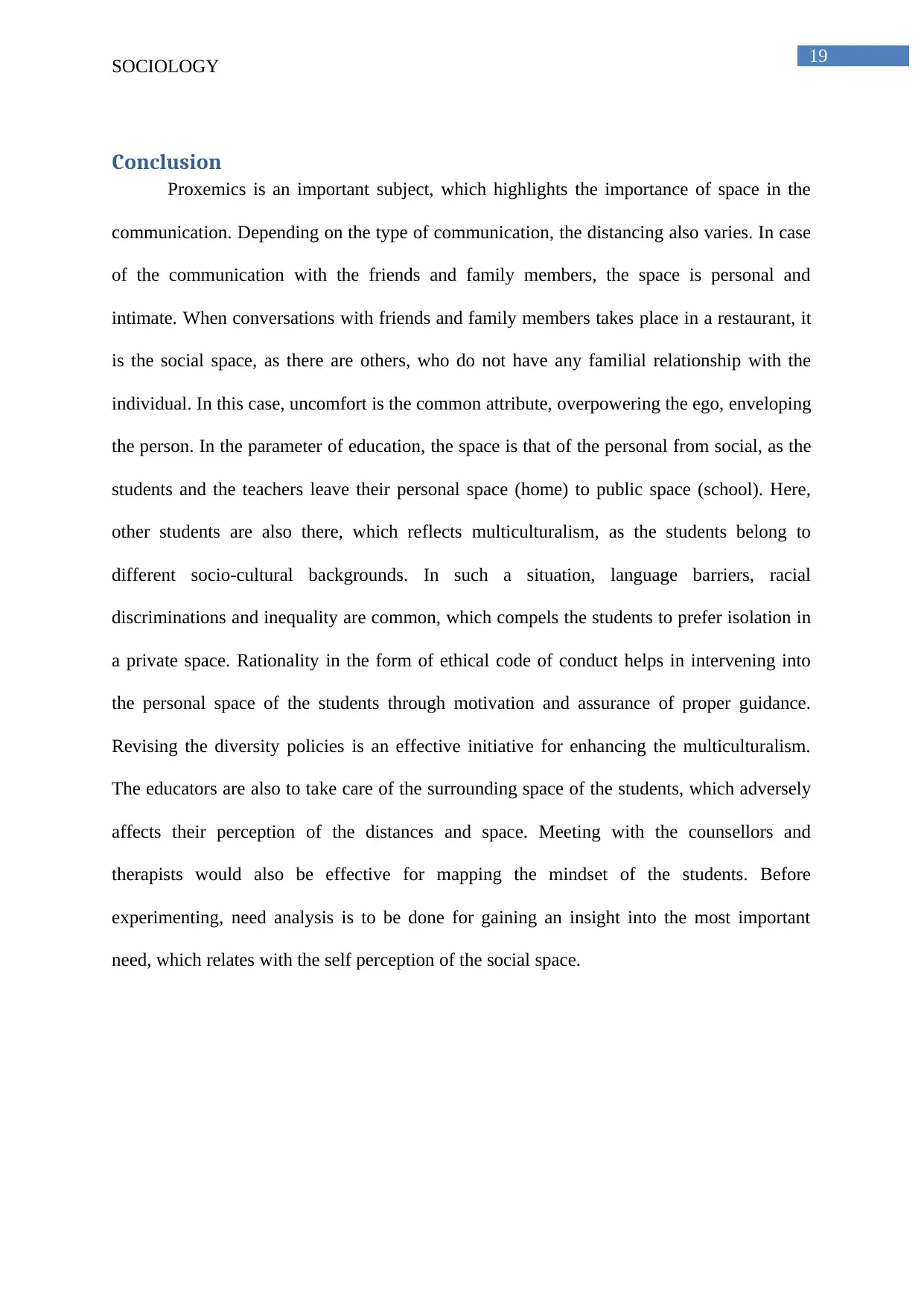
SOCIOLOGY
Conclusion
Proxemics is an important subject, which highlights the importance of space in the
communication. Depending on the type of communication, the distancing also varies. In case
of the communication with the friends and family members, the space is personal and
intimate. When conversations with friends and family members takes place in a restaurant, it
is the social space, as there are others, who do not have any familial relationship with the
individual. In this case, uncomfort is the common attribute, overpowering the ego, enveloping
the person. In the parameter of education, the space is that of the personal from social, as the
students and the teachers leave their personal space (home) to public space (school). Here,
other students are also there, which reflects multiculturalism, as the students belong to
different socio-cultural backgrounds. In such a situation, language barriers, racial
discriminations and inequality are common, which compels the students to prefer isolation in
a private space. Rationality in the form of ethical code of conduct helps in intervening into
the personal space of the students through motivation and assurance of proper guidance.
Revising the diversity policies is an effective initiative for enhancing the multiculturalism.
The educators are also to take care of the surrounding space of the students, which adversely
affects their perception of the distances and space. Meeting with the counsellors and
therapists would also be effective for mapping the mindset of the students. Before
experimenting, need analysis is to be done for gaining an insight into the most important
need, which relates with the self perception of the social space.
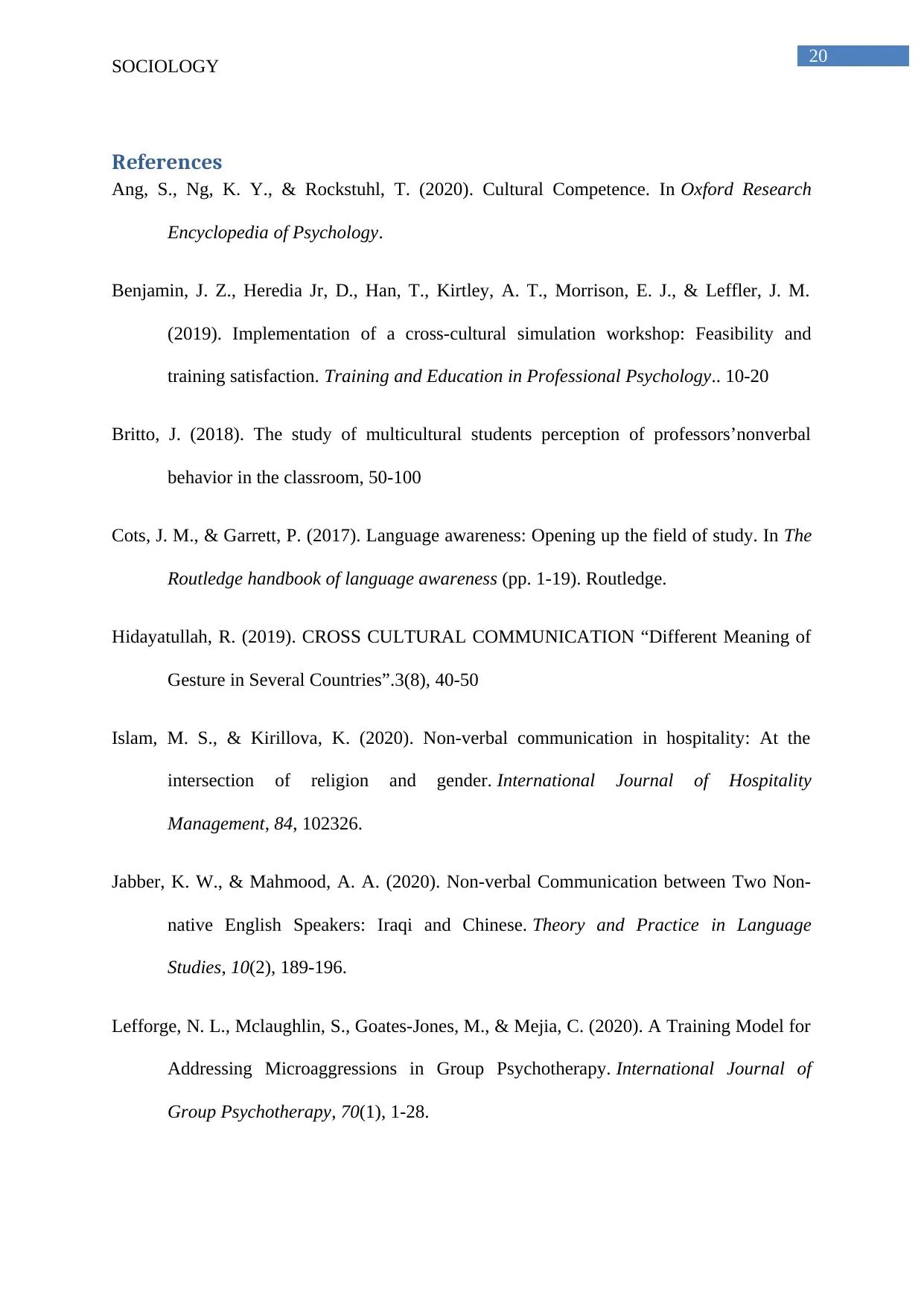
SOCIOLOGY
References
Ang, S., Ng, K. Y., & Rockstuhl, T. (2020). Cultural Competence. In Oxford Research
Encyclopedia of Psychology.
Benjamin, J. Z., Heredia Jr, D., Han, T., Kirtley, A. T., Morrison, E. J., & Leffler, J. M.
(2019). Implementation of a cross-cultural simulation workshop: Feasibility and
training satisfaction. Training and Education in Professional Psychology.. 10-20
Britto, J. (2018). The study of multicultural students perception of professors’nonverbal
behavior in the classroom, 50-100
Cots, J. M., & Garrett, P. (2017). Language awareness: Opening up the field of study. In The
Routledge handbook of language awareness (pp. 1-19). Routledge.
Hidayatullah, R. (2019). CROSS CULTURAL COMMUNICATION “Different Meaning of
Gesture in Several Countries”.3(8), 40-50
Islam, M. S., & Kirillova, K. (2020). Non-verbal communication in hospitality: At the
intersection of religion and gender. International Journal of Hospitality
Management, 84, 102326.
Jabber, K. W., & Mahmood, A. A. (2020). Non-verbal Communication between Two Non-
native English Speakers: Iraqi and Chinese. Theory and Practice in Language
Studies, 10(2), 189-196.
Lefforge, N. L., Mclaughlin, S., Goates-Jones, M., & Mejia, C. (2020). A Training Model for
Addressing Microaggressions in Group Psychotherapy. International Journal of
Group Psychotherapy, 70(1), 1-28.
⊘ This is a preview!⊘
Do you want full access?
Subscribe today to unlock all pages.

Trusted by 1+ million students worldwide
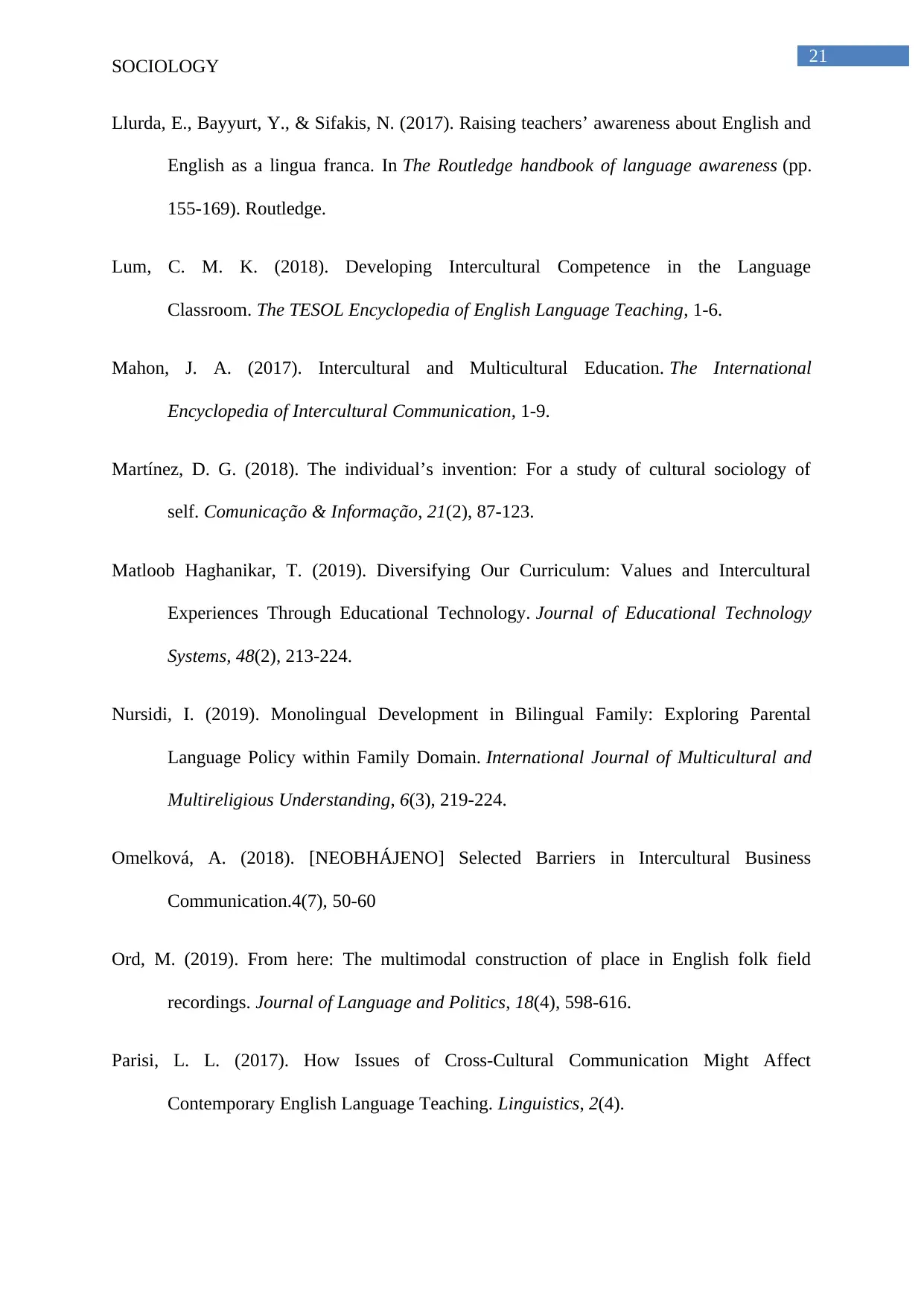
SOCIOLOGY
Llurda, E., Bayyurt, Y., & Sifakis, N. (2017). Raising teachers’ awareness about English and
English as a lingua franca. In The Routledge handbook of language awareness (pp.
155-169). Routledge.
Lum, C. M. K. (2018). Developing Intercultural Competence in the Language
Classroom. The TESOL Encyclopedia of English Language Teaching, 1-6.
Mahon, J. A. (2017). Intercultural and Multicultural Education. The International
Encyclopedia of Intercultural Communication, 1-9.
Martínez, D. G. (2018). The individual’s invention: For a study of cultural sociology of
self. Comunicação & Informação, 21(2), 87-123.
Matloob Haghanikar, T. (2019). Diversifying Our Curriculum: Values and Intercultural
Experiences Through Educational Technology. Journal of Educational Technology
Systems, 48(2), 213-224.
Nursidi, I. (2019). Monolingual Development in Bilingual Family: Exploring Parental
Language Policy within Family Domain. International Journal of Multicultural and
Multireligious Understanding, 6(3), 219-224.
Omelková, A. (2018). [NEOBHÁJENO] Selected Barriers in Intercultural Business
Communication.4(7), 50-60
Ord, M. (2019). From here: The multimodal construction of place in English folk field
recordings. Journal of Language and Politics, 18(4), 598-616.
Parisi, L. L. (2017). How Issues of Cross-Cultural Communication Might Affect
Contemporary English Language Teaching. Linguistics, 2(4).
Paraphrase This Document
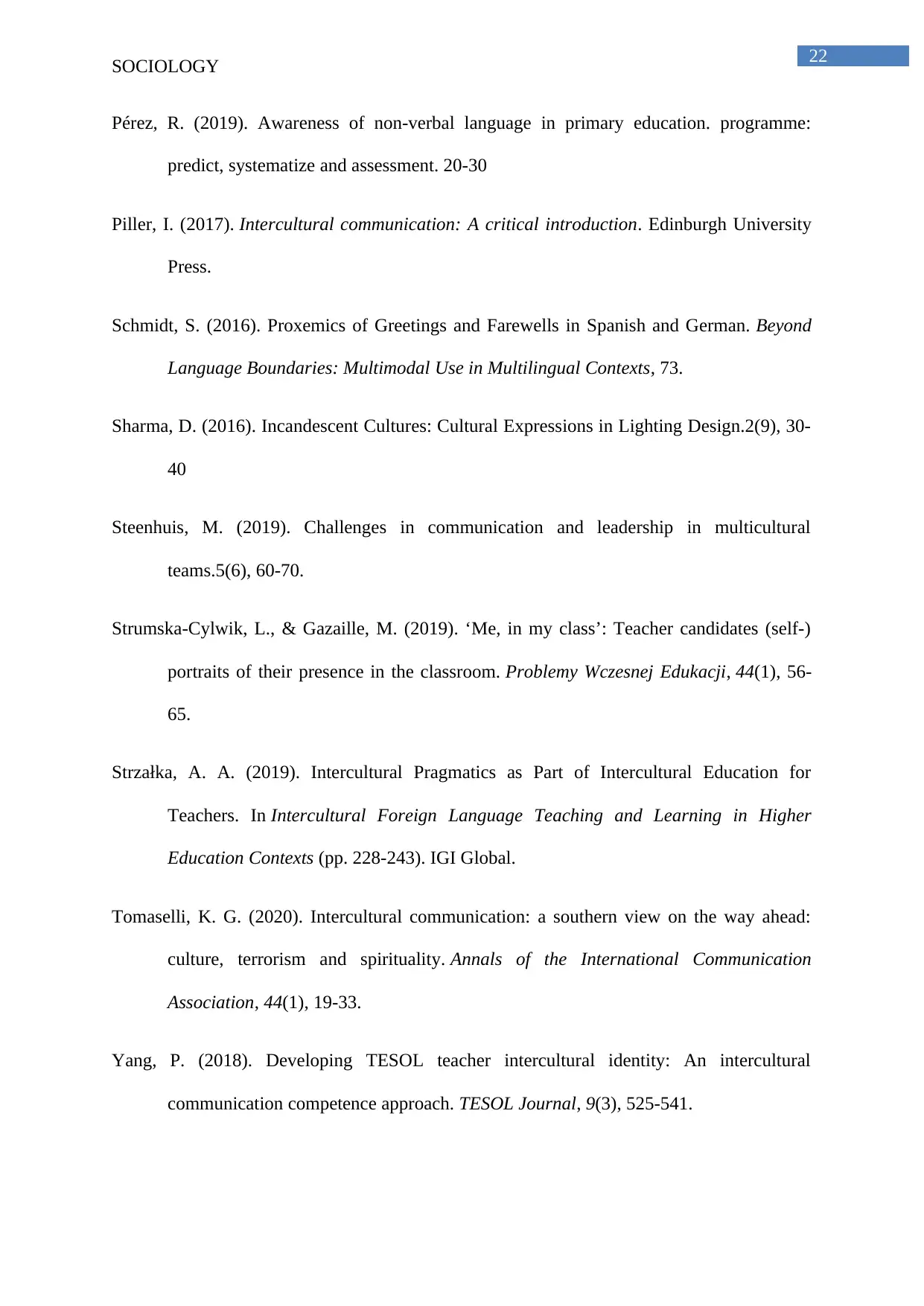
SOCIOLOGY
Pérez, R. (2019). Awareness of non-verbal language in primary education. programme:
predict, systematize and assessment. 20-30
Piller, I. (2017). Intercultural communication: A critical introduction. Edinburgh University
Press.
Schmidt, S. (2016). Proxemics of Greetings and Farewells in Spanish and German. Beyond
Language Boundaries: Multimodal Use in Multilingual Contexts, 73.
Sharma, D. (2016). Incandescent Cultures: Cultural Expressions in Lighting Design.2(9), 30-
40
Steenhuis, M. (2019). Challenges in communication and leadership in multicultural
teams.5(6), 60-70.
Strumska-Cylwik, L., & Gazaille, M. (2019). ‘Me, in my class’: Teacher candidates (self-)
portraits of their presence in the classroom. Problemy Wczesnej Edukacji, 44(1), 56-
65.
Strzałka, A. A. (2019). Intercultural Pragmatics as Part of Intercultural Education for
Teachers. In Intercultural Foreign Language Teaching and Learning in Higher
Education Contexts (pp. 228-243). IGI Global.
Tomaselli, K. G. (2020). Intercultural communication: a southern view on the way ahead:
culture, terrorism and spirituality. Annals of the International Communication
Association, 44(1), 19-33.
Yang, P. (2018). Developing TESOL teacher intercultural identity: An intercultural
communication competence approach. TESOL Journal, 9(3), 525-541.

SOCIOLOGY
Zhang, Y., Ding, B., Peng, P., & Bush, A. (2017, October). A Comprehensive Review of
Literature on Individual Cultural Intelligence. In 2nd International Symposium on
Business Corporation and Development in South-East and South Asia under B&R
Initiative (ISBCD 2017). Atlantis Press.
⊘ This is a preview!⊘
Do you want full access?
Subscribe today to unlock all pages.

Trusted by 1+ million students worldwide
Related Documents
Your All-in-One AI-Powered Toolkit for Academic Success.
+13062052269
info@desklib.com
Available 24*7 on WhatsApp / Email
![[object Object]](/_next/static/media/star-bottom.7253800d.svg)
© 2024 | Zucol Services PVT LTD | All rights reserved.




